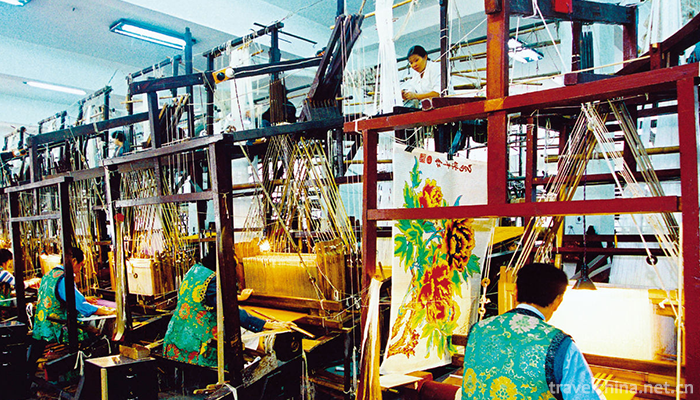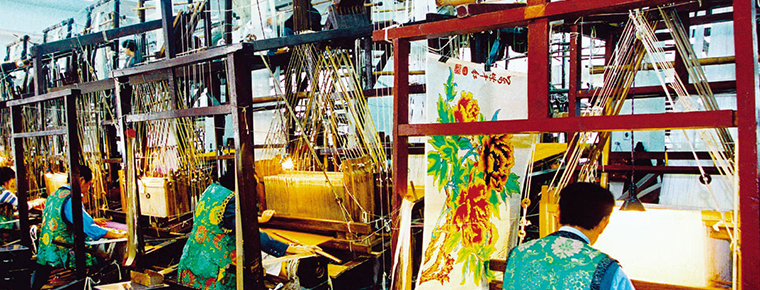Lu Brocade Weaving Techniques
Lu Brocade Weaving Techniques
Lujin brocade weaving technology, traditional handmade brocade weaving technology in Juancheng County, Shandong Province, is one of the national intangible cultural heritage.
The manufacturing process of Lu brocade weaving technology is complex. It needs 72 processes, such as spinning, dyeing, cloth pulp, warping, healing, breaking, cutting and weaving, to produce Lu brocade finished products.
On June 7, 2008, Lu brocade weaving technology was approved by the State Council of the People's Republic of China and included in the second batch of national intangible cultural heritage list, heritage number: _-103.
historical origin
The weaving of Shandong brocade has a long history. During the Yuan and Ming Dynasties, along with cotton planting on a large scale in the Yellow River valley, the people of Southwest Shandong kneaded the traditional techniques of Ge, Ma, silk and embroidery into cotton spinning, forming the cotton brocade in Southwest Shandong. At that time, Lu Jin's craftsmanship was relatively rough, with monotonous patterns and fewer varieties. With the renewal of textile machinery and the application of chemical dyes, Lu Jin process has been greatly improved.
In the Qing Dynasty, Juncheng Lu Jin was presented as a tribute to the court by local officials and became a precious treasure.
After the liberation of New China, the peasants in the land reform got their land. Cotton with high economic value has been widely planted. Despite the impact of three years of natural disasters and the 10-year Cultural Revolution, cotton planting area decreased for a time.
After the reform and opening up, foreign cloth occupied a large market share. But on the whole, due to the improvement of consumption capacity, the demand for cotton cultivation and cloth is much higher than before. The important reason for the rapid development of brocade weaving in Lu Dynasty is that the number and types of brocades accompanied by Lu Dynasty increased sharply in the 1980s.
Process characteristics
Types
Lujin brocade can be divided into two pieces (two pieces of plain weave fabric) and four pieces (four pieces of twill weave fabric or variational weave fabric) according to the number of heddles used in weaving.
Lujin brocade is classified according to the weaving effect of the color on the surface of the fabric, including stripes, checks, jujube pattern, water pattern, combo pattern, goose-eye pattern, Jewish hoof pattern and so on. According to weaving techniques, Lu brocade can be classified into five categories: jacquard Lu brocade, canvas instead of brocade, Dahua Lu brocade, Baohua Lu brocade and Tinhua Lu brocade.
Lufei is classified into stripes, checks, jujube pattern, water pattern, combo pattern, goose-eye pattern and Jewish hoof pattern according to the effect of weaving on the surface of the fabric. According to weaving techniques, Lu brocade can be classified into five categories: jacquard Lu brocade, canvas instead of brocade, Dahua Lu brocade, Baohua Lu brocade and Tinhua Lu brocade.
- Patterns
In the long weaving years, skillful farm women have constantly innovated and improved Lu brocade technology, gradually forming a unique style of modern jacquard, floral, and flower-picking technology, which is rich and beautiful, rough and refined. The pattern of Lu Jin has developed from the initial twill, stripe and square pattern to the more complex pattern of jujube pattern, water pattern, combo pattern, goose-eye pattern, cat's hoof pattern.
The various shapes of Lu Jin patterns are not confined to the reality of objective things, but a subjective and arbitrary creation, which is in line with the people's inner requirements and aesthetic feelings, and is an aesthetic realm of "complacency and forgetfulness of images". The artistic conception of Lu Jin's design is embodied by various geometric shapes interwoven with various color lines, rather than the concrete image of things. Parallel, repetitive and continuous through abstract patterns. Spacing, contrast and other changes, forming a unique rhythm and rhythm, it reflects the life of the form is tortuous, indirect, and therefore more artistic charm.
Color
The commonly used colors of Lu Jin are bright red, peach red, Lake blue, indigo, green, black, yellow, brown, white, etc. Lu Jin's color is very bold, the color contrast is strong, the style is bright and bright, which reflects the bold and relaxed personality. Lu Jin's requirement for color matching is bright, which is the aesthetic of color matching, and is also the principle and standard of Lu Jin's use of color. Bright standard is to choose high brightness and purity of color, strong contrast, with a very strong decorative effect, give people a bright, warm feeling. The combination of different patterns and the interweaving of different color lines make Lu Jin present different artistic effects.
Technological process
Lu brocade weaving needs nine main processes, including warp spinning, dyeing, pure yarn, warp yarn, threading, brushing, reeling, crane and weaving, each of which includes many sub-processes. Use spinning wheel, spindle, warp pole, warp fence, bar, brush, loom, shuttle and other tools. Reeling is an important process in brocade weaving. The more the reeling, the more the changes of the texture formed, and the more colorful the pattern of the fabric. Machine weaving can only weave two and four reels, while hand-woven Lu brocade can weave six and eight more complex reels.
The weaving of two reel fabrics is relatively simple. There are only two reels on the loom. There are two feet creeping under the loom. When you step on the first foot, you pull the warp thread and form a knitting opening. The right hand shuttle, the left hand shuttle, the second foot creeping, closing the knitting opening, and moving the rope frame to tighten the weft, you complete a weaving process. In this way, if you weave with a single-color weft of a shuttle, you can weave more than 30 feet of cloth a day. Because the change of two reels only has the fixed law of opening and closing up and down, besides the change of weft color, the fabric texture has no obvious undulating texture, so the two reels are usually called plain weaving.
Although the weaving process of the four reels is the same as that of the two reels, the increase of reels determines the difficulty of weaving. The order of the four feet under the loom in weaving different patterns and the order of the two groups of combination are also different. Each time two feet are stepped down, different longitudes are driven to form opening. After shuttle throwing and weft transferring, the other feet are stepped down to tighten the longitude, and the weft is tightened by rope frame. It's not the last combination of two feet when you step on tiptoe again, but different adjustments according to the fabric design.
When weaving Lujin brocade, different numbers of shuttles are usually prepared according to the design of the fabric. There are at least one shuttle and at most a dozen shuttles. Usually 4-5 shuttles are used most. The more the shuttle is used, the richer the color is, but frequent shuttle change will affect the speed of weaving, so the more the color of weft, the lower the weaving efficiency of fabric.
Inheritance and protection
Inheritance value
Lu brocade weaving technology uses natural raw materials, pure manual weaving, with antistatic, non-deformable, breathable sweat absorption, warm winter, cool summer and many other advantages. Jiaxiang County has developed many exquisite brocade products, such as clothing, home textiles, bags, jewelry and so on. It caters to the needs of all kinds of people and enables people to experience comfort and health in green consumption and feel simple and elegant.
Inheriting characters
Zhao Fangyun, female, Han nationality, born in July 1944 in Gaozhuang Village, Zhongshan Township, Jiamian County, Shandong Province. In June 2009, Zhao Fangyun was selected as the representative successor of the third batch of national intangible cultural heritage projects. Jiaxiang County of Jining City declared the project: Lu brocade weaving skills.
protective measures
In December 1995, the Lu Jin Art Museum of China was established in Juancheng, and Lu Jin's manufacturing skills were inherited and protected.
In January 2005, Juncheng Lujin Handicraft Co., Ltd. was designated as "Shandong Tourism Commodity Research and Development Base" by Shandong Tourism Bureau, devoted to the protection of Lujin weaving skills.
social influence
Honorary commendation
In May 2004, Lu Jin won the Excellent Award in the "Golden Doctor Cup" National Rural Youth Arts and Crafts Design Competition sponsored by the Central Committee of the Communist Youth League and the Chinese Artists Association;
On June 8, 2007, Shandong - Chenglujin Museum won the first Cultural Heritage Day Award promulgated by the Ministry of Culture.


-
1.Beijing Roast DuckPeking duck
Roast duck is a world-renowned Beijing dish, which originated in the Northern and Southern Dynasties of China. It has been recorded in the Record of Food Treasures and was a palace food at that time.P
Time 2018-10-27 -
2.Yungang Grottoes
Yungang Grottoes is located in the southern foot of Wuzhou Mountain, 17 kilometers west of Datong City, Shanxi Province, northern China.
Time 2018-11-24 -
3.Anhui rescue
Anhui rescue Great rescue is a traditional feature of Shouxian County in Anhui Province, which has a history of more than 1000 years.
Time 2018-11-27 -
4.Ancient Huaihe River Cultural Ecological Scenic Area
The ancient Huaihe River cultural and ecological scenic spot is located in Qingjiangpu District, Huai'an City, Jiangsu Province. It is a national AAAA-level tourist scenic spot. The scenic spot is an
Time 2019-01-12 -
5.Mingyue Gorge Scenic Area
Mingyue Gorge is located in the eastern section of Jialing Jiangxi Lingxia, Guangyuan, Sichuan Province. It covers an area of 6.1 square kilometers and is about 33 kilometers
Time 2019-02-07 -
6.Poyang Lake National Nature Reserve
Jiangxi Poyang Lake National Nature Reserve is located in the north of Jiangxi Province. It is a nature reserve for wildlife protection. The main protected objects are rare migratory
Time 2019-02-07 -
7.Firing Techniques of Copper Official Ceramics in Changsha Kiln
Changsha kiln copper official ceramics firing technology, Hunan Province's traditional handicraft, one of the national intangible cultural heritage.
Time 2019-07-25 -
8.Guo Moruo
Guo Moruo (1892 1978), formerly known as Guo Kaizhen, the word Ding Tang, the warrior, the baby name leopard, the pseudonym of Mo, Michael, Guo Dingtang, Shi Tuo, Gao Ruhong, Yang Yi and so on. Born i
Time 2019-09-07 -
9.Guo Ziyi
Guo Ziyi (697 - 781 years), Zi Zi Yi, Iowa Zheng county (now Shaanxi) Weinan city Hua Zhou District ) People. The famous Tang Dynasty Politician , Militarist
Time 2019-09-07 -
10.Luodai Ancient Town
Luodai Ancient Town is located in Longquanyi District, Chengdu City, Sichuan Province, with a total area of more than 20000 square meters. Luodai Ancient Town is a national historical and cultural town and one of the five "Dongshan five fields" in Chengdu.
Time 2020-11-05 -
11.Neijiang tertiary industry
In 2019, the investment in real estate development in Neijiang City will increase by 2.7% over the previous year. The construction area of commercial housing was 12.4341 million square meters, an increase of 8.9%. The sales area of commercial housing was 4.6939 million square meters, an increase of 8.0%.
Time 2020-12-16 -
12.Biological resources in Dazhou
There are more than 400 species of vertebrates in Dazhou City, including 60 kinds of mammals, 230 kinds of birds, 14 kinds of reptiles, 10 kinds of amphibians and 85 kinds of fish. There are 52 species of national and provincial key protected wild an
Time 2020-12-20